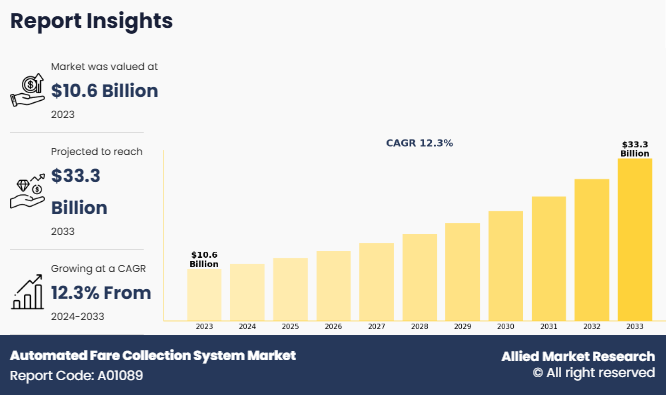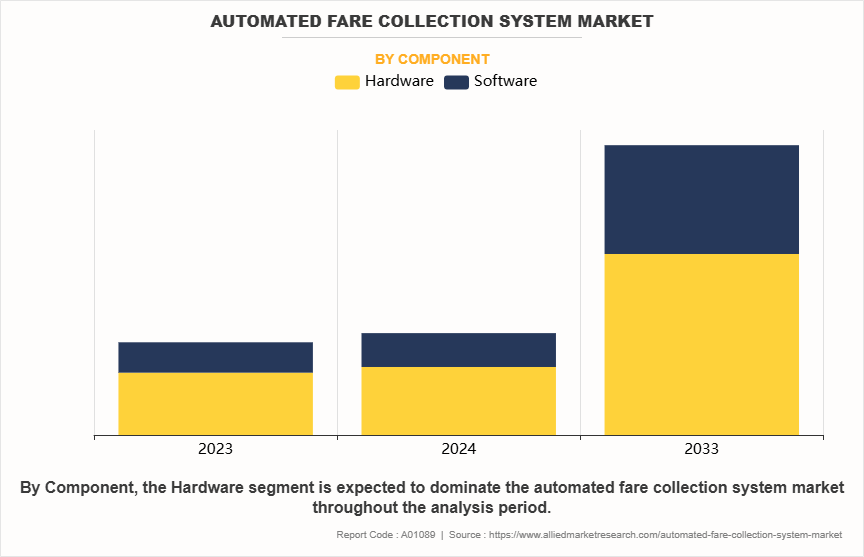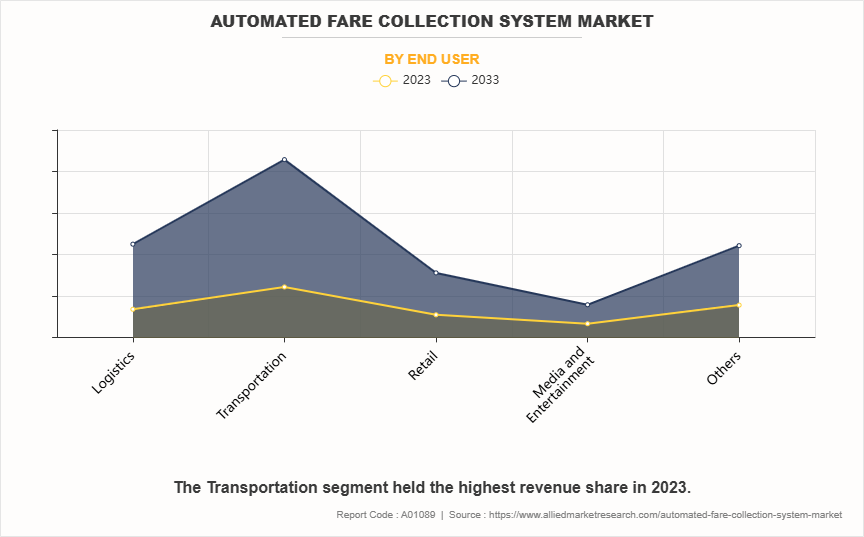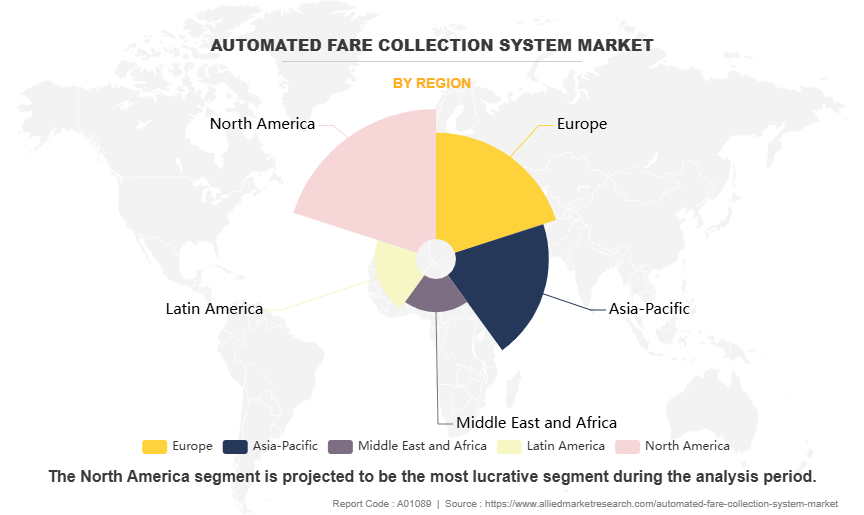Automated Fare Collection System Market Research, 2033
The global automated fare collection system market size was valued at $10.6 billion in 2023, and is projected to reach $33.3 billion by 2033, growing at a CAGR of 12.3% from 2024 to 2033.

Report Key Highlighters:
The automated fare collection system market study covers 14 countries. The research includes regional and segment analysis of each country in terms of value ($Billion) for the projected period 2024-2033.
The study integrated high-quality data, professional opinions and analysis, and critical independent perspectives. The research approach is intended to provide a balanced view of global markets and to assist stakeholders in making educated decisions in order to achieve their most ambitious growth objectives.
Over 3,700 product literature, annual reports, industry statements, and other comparable materials from major industry participants were reviewed to gain a better understanding of the market.
The automated fare collection system market share is highly fragmented, into several players including Cubic Transportation Systems, Inc., Indra Sistemas S.A, LECIP HOLDINGS CORPORATION, Siemens AG, Thales Group, OMRON Corporation, Scheidt & Bachmann GmbH, Advanced Card Systems Ltd., Hitachi, Ltd., NXP Semiconductors and others to improve their market positioning.
Automated fare collection system is an integration of technologies to ease the ticketing process at public transportation network including buses, metro and car rental and at toll centers. It is a contactless, end-to-end solution for collecting fare payments and replacing traditional ticketing system with automated ticketing. Automated fare collection system comprises various components including automatic gate machines, ticket vending machines, recharging terminals, and ticket checking machines. This system facilitates efficiency in fare collection, improves the overall transaction rate, and saves extensive amount of time, thereby, minimizing waiting time in queues and searching for cash to buy tickets.
The automated fare collection system market growth is driven by growing trend towards contactless payments, growing urbanization, and increasing investment by government on development of public transportation system. However, factors such as high investment cost and cybersecurity challenges and security concerns are anticipated to hinder the growth of the market to some extent. On the contrary, development of high-speed internet and 5G networks, and growth in advancement in multi-modal transportation solutions are expected to offer lucrative growth opportunity during the forecast period.
In recent decades, the growing population in cities and increasing emphasis of governments to develop public transportation system to reduce congestion on road have led to significant increase in investment in public transportation system. Governments across the world are investing heavily in public transit options such as buses, metro system, and light rail systems. Public transportation also helps in reducing the environmental impact of urban mobility, similarly governments are also focusing on powering electric buses, light rail, and metro systems with renewable energy sources. Furthermore, the growing investment in public transportation has resulted in increased usage of public transportation to meet its rising demand. To meet this, companies are working with government agencies to install automated fare collecting systems in urban areas. For instance, on April 29, 2024, the National Transportation Authority of Ireland announced the signing of agreements with Indra Sistemas S.A. According to the agreement, the company will manage the fare collection system for the trams, buses, national rail network, and the future Dublin MetroLink while utilizing its innovative technology and its ability to manage complex projects. The primary aim of the agreement is to improve the user experience and facilitate payment with a bank card (EMV) or mobile phone, the agreement also aims to provide best fares rate and discounts while utilizing Indra account-based ticketing management system.
However, the installation of automated fare collection system (AFCS) in transport networks require high cost, which includes installing payment collection equipment and checking devices, setting of communication network (wired networks), and installing network equipment, fixing the installed system hardware, fine-tuning and testing system hardware, and interaction between system components. Bus and taxi transportation service providers require handheld collection devices, while subways and trains require a much bigger infrastructure. This increases the overall installation cost, which hinders the stated growth.
Moreover, in magnetic fare cards, magnetic stripes can be unintentionally erased or damaged using objects such as refrigerator magnets. Regular maintenance activities are the key task for automated fare collection system as it is directly associated with seamless operations without error. These maintenance activities require a highly skilled workforce and high skilled MRO workforce incurs high maintenance costs. The operational cost of technology is on the higher side as compared to the conventional method. This high maintenance cost impacts the overall cost and expenses of the AFC system.
Segmental analysis
The automated fare collection market is segmented on the basis of component, technology, end-user, and region. On the basis of component, the global market is segregated into hardware and software. By technology, the market is categorized into smart card, magnetic stripe, near-field communication (NFC), radio frequency identification (RFID), biometrics, and others. On the basis of end user, the global market is segmented into logistics, transportation, retail, media and entertainment, and others. Region wise, the market is analyzed across North America, Europe, Asia-Pacific, Middle East and Africa, and Latin America.
By Component
By component, the automated fare collection system market has been segregated into hardware and software. The hardware segment accounted for the largest market share in 2023, owing to hardware being majorly used to improve the passenger experience in public transport networks. Additionally, the hardware are essential at contactless payment terminals, mobile ticketing systems, and other self-service kiosks, facilitates quick and easy fare payments, thus reducing overall wait times and making public transportation more user friendly.

By Technology
By technology, the smart card segment accounted for a dominant market share in 2023 owing to smart cards being embedded with a microprocessor or memory chip that can store and process data, allowing passengers to load monetary value or travel credits and use it to pay for their trips. Smart Card is a widely accepted mode of fare payment as it is cost effective solution with high feasibility in all transit environments. In recent years, smart cards are becoming the mainstream payment medium across all the public transport platforms, which enables passenger for low time and ease in process to eliminates the long queues and hard cash availability issues. Transit operators find it extremely difficult to adjust the service to meet the high demand, because this demand changes continuously with the time or day of travel. Therefore, some large cities around the world take advantage of smart card capabilities to manage their transit networks by using smart card automated fare collection systems (SCAFCS).
[TECHNOLOGYGRAPH]
By End User
By end user, the transportation segment accounted for a dominant market share in 2023, owing to increasing use of automated fare collection system in ticketing, payment, and fare collection for public and private transportation services. The demand for automated fare collection in the transportation sector is driven by increased penetration of smart cards and QR code-based payment methods. The automation of fare collection system enables transportation agencies and authorities to reduce the operational costs associated with staffing ticket counters, handling cash, and printing physical tickets. There has been growing adoption of automated fare collection systems in countries across the world. For instance, data from National Highways Authority of India (NHAI) showcased that toll collected through FASTags accounts for almost 70% of the toll transactions across the country.

Region
Region wise, North America held the largest market share in 2023, driven by several technological advancements in the region, especially in the U.S. and Canada. Increase in road accidents and traffic congestion are the major factors that boost the adoption of AFCS in toll collection across the region. The government in the region are also increasing their focus to implement automated fare collection system for instance, Canada launched iBus technology to meet customer expectation and improve speed and reliability of the overall transportation network. The region also has a presence of prominent players such as Cubic Transportation and BEA Transit solutions, which are heavily investing in automated fare collection systems in these countries. In Canada, for instance, to reduce preventive measures against the spread of COVID-19 virus, in August 2020, OC Transpo entered into an agreement with Scheidt & Bachmann (S&B) to fast-track additional contactless fare payment technology on its bus fleet and at O-Train stations with fare gates. This project announced that they will accept payment through MasterCard, Visa, Google Pay and Apple Pay. The governments in the region are focusing heavily on shifting fully towards automated fare collection system market trends in the region, which will be the major driving factor for the growth of the market in the region.

Growth in Trend Towards Contactless Payments
In recent years, there has been increase in usage of contactless payments across the world. As modern cities are developing and cities are relying increasingly on public transportation system, there has been increase in adoption for contactless payments as they allow to efficiently monitor the money and provide a faster and efficient way of collecting fares.
Similarly, in recent years, there has been growth in advancement in NFC and e-wallet technologies which process the payment faster and also provide security. Furthermore, many cities are integrating single payment options which allows passengers to use a single contactless card or app to pay for multimodal transportation systems, such as buses, trains, bikes, and even parking.
On September 10, 2024, Visa Inc. and The Bank of America Corporation announced that since the pandemic, the company has witnessed an increase in contactless payments and usage of digital wallets and other taps to pay technologies.For instance, Visa Inc. Senior Vice President and Head of U.S. Merchant Chris Baker, along with Bank of America Managing Director and Vendor of third party and network management Sara Walsh, announced that on an average, more than 30 cities in the U.S. have contactless payment penetration of more than 60%.The companies also announced New York City MTA system has the highest penetration of contactless payments and the system utilizes around 75% of face-to-face and contactless transactions. Major cities around the world are supporting the use of automated fare collection systems and with the growth in contactless payment services, the market is expected to witness a strong growth rate during the forecast period.
Growth in Advancement in Multi-Modal Transportation Solutions
In the modern world, there has been increase in the use of multi-model transportation solutions to travel from one destination to another. Moreover, there has been a growth in the use of high-speed public transport and high-speed metro trains & monorails, which are expected to foster the growth of the market, thereby enabling high revenue generation for operators. Tickets are issued as paper tickets or electronic tickets that can be bought either in advance or at the time of the ride, through automated fare management system, which is expected to create ample number of opportunities for the key players operating in the global automated fare collection system industry. Furthermore, many organizations offer one or more than one mode of multiple-ride passes and discounted multi-ride options such as months, weekly, and daily passes. Mobile ticketing model is preferred over other modes of payment. This model comprises a registered mobile subscription, which can be either prepaid or postpaid. A traveler's identity is known by scanning his/her mobile number at the entrance or exit of a vehicle and then the amount is deducted from the balance in the mobile as per the distance travelled by the passenger.
Key Benefits For Stakeholders
This report provides a quantitative analysis of the market segments, current trends, estimations, and dynamics of the automated fare collection system industry analysis from 2024 to 2033 to identify the prevailing automated fare collection system opportunities.
The market research is offered along with information related to key drivers, restraints, and opportunities.
Porter's five forces analysis highlights the potency of buyers and suppliers to enable stakeholders make profit-oriented business decisions and strengthen their supplier-buyer network.
In-depth analysis of the market segmentation assists to determine the prevailing market opportunities.
Major countries in each region are mapped according to their revenue contribution to the global market.
Market player positioning facilitates benchmarking and provides a clear understanding of the present position of the market players.
The report includes the analysis of the regional as well as global automated fare collection system market size, trends, key players, market segments, application areas, and market growth strategies.
Automated Fare Collection System Market Report Highlights
| Aspects | Details |
| Market Size By 2033 | USD 33.3 billion |
| Growth Rate | CAGR of 12.3% |
| Forecast period | 2023 - 2033 |
| Report Pages | 280 |
| By Component |
|
| By Technology |
|
| By End User |
|
| By Region |
|
| Key Market Players | Siemens AG, Scheidt & Bachmann GmbH, Advanced Card Systems Ltd., NXP Semiconductors, Hitachi, Ltd., Thales, Omron Corporation, Cubic Corporation, Indra Sistemas, LECIP HOLDINGS CORPORATION |
Analyst Review
Automated Fare Collection System (AFCS) is an automated system that helps transit operator to trace and account for the revenue, simultaneously providing a more convenient way of payment instead of cash. It comprises ticket/card validators, reloading terminals, inspector machines, balance checkers, ticket vending machines, and turnstile gates. With the development of technologically advanced products and increasing need for traffic management at toll ways and other public transport sectors, the AFCS market has shown prominent adoption in developed regions. Smart cards, NFC, OCR, and magnetic stripes/bar codes are the major technology platforms used in the automated fare collection systems. Geographically, North America holds the largest market share, owing to early adoption of the technology in various transit modes such as buses, trains, car rental and toll ways.
In the past, manual processing systems were utilized by transit agencies, but now they have switched to smart card ticketing systems. Smart cards are easy to carry, offering passengers with a safe, reliable, and efficient payment. They have various functions such as storing the location of the passengers (boarding location) and handling all fare categories including single-trip fares, period passes, and special fares, offering concession on fare for specific population groups as well. Further, companies are now concentrating on manufacturing of AFC systems that support ticketing through NFC-enabled smartphone. In addition, use of electronic toll collection is increasing; this has benefited the customer by reducing the waiting line at toll plazas, which helps in saving time, especially on highways. The AFCS market in Asia-Pacific is expected to grow rapidly from 2016 to 2022 owing to development of monorails and metro services in various developing countries of the region.
Reduced waiting time in queues, improvisation in public transport, quick and faster transactions, flexible fare plans, reduced traffic congestion, and reduction in fraud rates are some of the key factors that drive the growth of the automated fare collection market. On the other hand, high installation, high maintenance cost, e-payment, and manual processing systems restrict the market growth.
As of 2015, Thales Group, Advanced Card Systems, and Cubic Transportation System were the two highest revenue-generating companies. These companies are launching new products with enhanced technologies according to the demand of transit agencies. In addition, they are entering into various partnerships with potential market players to enhance the product quality.
Integration of AI and ML are the upcoming trends of automated fare collection system.
The transportation segment is the is the leading application of automated fare collection system market.
North America is the largest regional market for automated fare collection system.
The global automated fare collection system market was valued at $10,639.0 million in 2023, and is projected to reach $33,257.0 million by 2033.
Cubic Transportation Systems, Inc., Indra Sistemas S.A, LECIP HOLDINGS CORPORATION are some of the major companies operating in the market.
Loading Table Of Content...
Loading Research Methodology...



